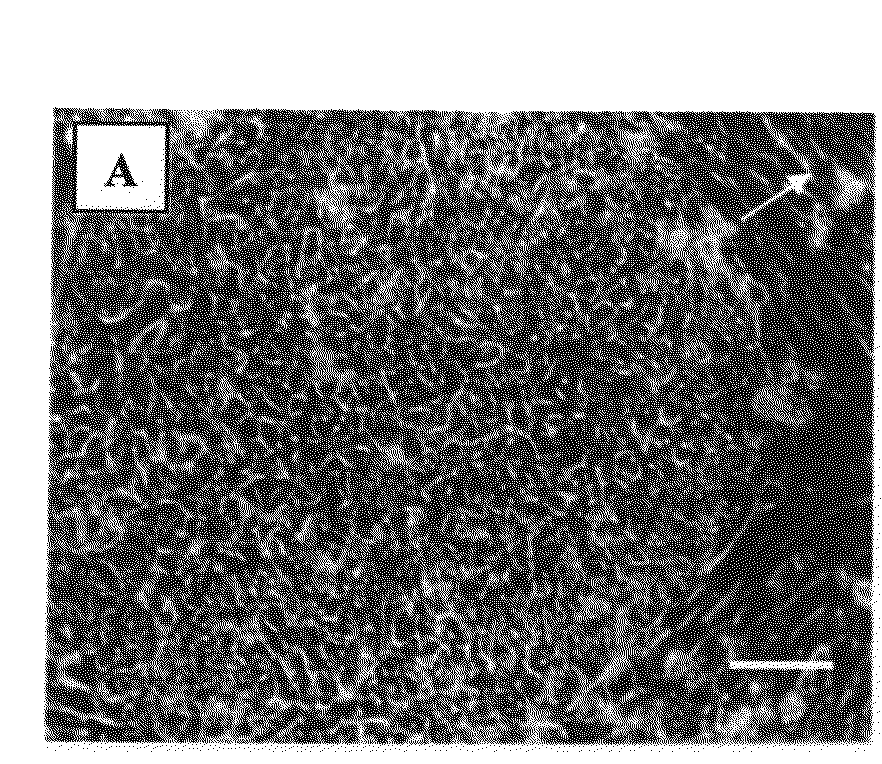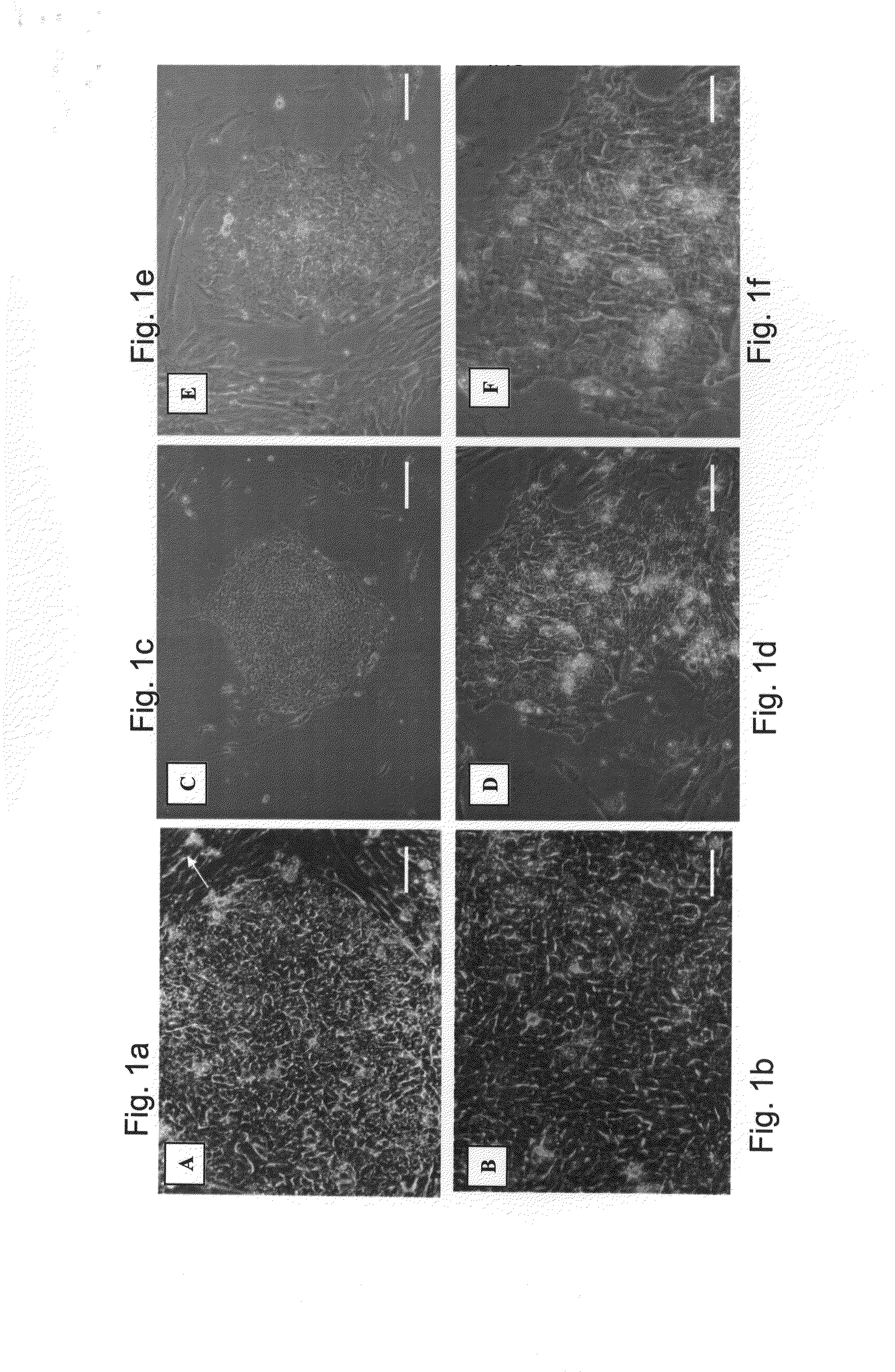Media for culturing stem cells
a stem cell and media technology, applied in the field of culture media, cell culture and method of culturing stem cells, can solve the problems of inability to accurately repeat, affect the quality of culture, and limit the potential of large-scale culturing of hescs,
- Summary
- Abstract
- Description
- Claims
- Application Information
AI Technical Summary
Benefits of technology
Problems solved by technology
Method used
Image
Examples
example 1
Culturing Human Embryonic Stem Cell with a Medium Containing the IL-6-IL-6 Receptor (IL6RIL6) Chimera
[0187]To optimize culturing conditions of hESCs on feeder-layer free culturing systems, the present inventors have tested various combinations of growth factors, as follows.
[0188]Materials and Experimental Methods
[0189]hESC culture—Human embryonic stem cell (hESC) lines I-6 and I-3 [Amit & Itskovitz-Eldor, 2002] were cultured for 46 and 39 passages respectively, with inactivated mouse embryonic fibroblasts (MEFs) in an “hESC basic culture medium” consisting of 85% Ko-DMEM, supplemented with 15% serum replacement (SR), 2 mM L-glutamine, 0.1 mM β-mercaptoethanol, 1% non-essential amino acid stock, and 4 ng / ml bFGF (all Gibco Invitrogen Corporation products, Grand Island N.Y., USA).
[0190]To test various media combinations on feeder-layer free culturing systems, hESCs were transferred to 50 μg per 10 cm2 fibronectin-covered plates (human plasma fibronectin, Chemicon International, Temecu...
example 2
Culturing Human Embryonic Stem Cell with a Medium Containing TGF-Beta Isoforms Devoid of Serum, Serum Replacement and Albumin
[0217]Materials and Experimental Methods
[0218]ESC culture—Human embryonic stem cell (hESC) lines I-6, I4 and I-3 [Amit & Itskovitz-Eldor, 2002] were cultured with inactivated mouse embryonic fibroblasts (MEFs) for 40-60 passages in a “basic hESC culture medium” consisting of 85% DMEM / F12 (Biological Industries, Biet Haemek, Israel) supplemented with 15% serum replacement (SR), 2 mM L-glutamine, 0.1 mM β-mercaptoethanol, 1% non-essential amino acid stock, and 4 ng / ml basic fibroblast growth factor (bFGF) (all Gibco Invitrogen Corporation products, Grand Island N.Y., USA).
[0219]To test the ability of various culture media to support the growth of hESC in an undifferentiated yet pluripotent state the hESCs were transferred to several culture systems:
[0220](i) Fibronectin feeder-free culture system—50 μg per 10 cm2 fibronectin-covered plates (human plasma fibronec...
example 3
Evaluation of the Capacity of the TGFβ-Containing Media Devoid of Serum, Serum Replacement and Albumin to Support Derivation of hESC Line on Foreskin Fibroblasts in a Complete Xeno-Free System
[0254]Materials and Experimental Methods—as in Example 2, hereinabove.
[0255]Experimental Results
[0256]The HA16 and D2 media are suitable for derivation of hESC line on foreskin fibroblast feeder layers in a complete xeno-free system—The medium combinations of the present invention were also tested for the ability to support hESC line derivation. While using the HA16 or D2 medium on foreskin fibroblasts as a supportive layer, new hESC lines were successfully derived and maintained for at least 2 passages (in the presence of the D2 medium) or at least 18 passages (in the presence of the HA16 medium). The hESC line derived on foreskin in the presence of the HA16 culture medium demonstrated stem cells morphology at passage 18 (and the culture is still ongoing), normal XY karyotype and pluripotency ...
PUM
| Property | Measurement | Unit |
|---|---|---|
| concentration | aaaaa | aaaaa |
| concentration | aaaaa | aaaaa |
| concentration | aaaaa | aaaaa |
Abstract
Description
Claims
Application Information
 Login to View More
Login to View More - R&D
- Intellectual Property
- Life Sciences
- Materials
- Tech Scout
- Unparalleled Data Quality
- Higher Quality Content
- 60% Fewer Hallucinations
Browse by: Latest US Patents, China's latest patents, Technical Efficacy Thesaurus, Application Domain, Technology Topic, Popular Technical Reports.
© 2025 PatSnap. All rights reserved.Legal|Privacy policy|Modern Slavery Act Transparency Statement|Sitemap|About US| Contact US: help@patsnap.com



